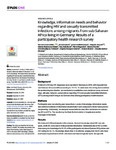Knowledge, information needs and behavior regarding HIV and sexually transmitted infections among migrants from sub-Saharan Africa living in Germany: Results of a participatory health research survey
Koschollek, Carmen
Kuehne, Anna
Müllerschön, Johanna
Amoah, Stephen
Batemona-Abeke, Helene
Bursi, Taty Dela
Mayamba, Pierre
Thorlie, Adama
Mputu Tshibadi, Christina
Wangare Greiner, Virginia
Bremer, Viviane
Santos-Hövener, Claudia
Background: A total of 3,419 new HIV diagnoses were reported in Germany in 2016, with migrants from sub-Saharan Africa (misSA) accounting for 14.1%. To understand the driving factors behind the epidemiological situation, we conducted a quantitative cross-sectional survey on knowledge, attitudes, behavior, and practices regarding HIV and sexually transmitted infections (STIs) among misSA living in six German cities utilizing participatory health research. Methods: Participants were recruited by peer researchers. Levels of knowledge, information needs, and preferred methods of information dissemination were analyzed to inform future prevention planning. Additionally, we analyzed sexual behavior and other risk factors for contracting HIV and STIs. The results may facilitate the formulation of targeted prevention messages in the future. Results: We included 2,432 participants in the analysis. General knowledge about HIV was adequate, as 86.9% were aware of the presented information. Statements about HIV co-infections were prior knowledge for 53.4% of the participants and about German HIV policies and HIV testing for 54.7%. Knowledge about other STIs differed, ranging from 69.6% who have ever heard of gonorrhea to 23.8% who have ever heard of genital warts. Groups with particular knowledge gaps were i) younger misSA, ii) recent migrants, iii) misSA without regular access to the German health care system, iv) misSA of lower socioeconomic status, and v) misSA with Muslim religious affiliation. The majority of participants reported information needs (72.8%), and 71.3% wanted to obtain this information from health professionals. Male misSA were more likely to report five or more sexual partners compared to females. Less than half of participants reported always using condoms with non-steady sexual partners (46.8%). Reasons for not using condoms differed between males and females. A considerable proportion of females (16.3%) and males (6.8%) experienced sexualized violence. More than one fourth of women (26.9%) were affected by female genital mutilation/cutting. Discussion: Future prevention planning should focus on sub-groups with particular knowledge gaps, recognizing their preferred methods of information dissemination. Prevention messages for male misSA should focus on their own risk perception and for female misSA on empowerment, e.g. to negotiate condom use.
Files in this item
References

